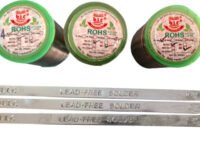Description
B.I.C PB-Free Solder Wires available in below compositions:
– 99.3 Sn/ 0.7 Cu
-99 Sn/ 1 Cu
– 99 Sn/ 3 Cu
Available Swage: 14, 16, 18 , 20 , 22 , 23 swg
Available Flux Type: No Clean / Resin Core
Avialable Flux Ratio: 1.6%, 1.8%, 2.0%, 2.2%,2.5%, 2.8%, 3.0%
Melting Temperature:
- Effective melting temp for Sn/Ag solder is 240*C but the higher melting temp of Pb-free solders requires reflow to occur above 240*C.
The recommended soldering or reflow profile must assure a minimum time above 240°C that takes into account equipment temperature tolerances, and with varying product and component size and mass.
The typical reflow temperature range for Pb-Free (Sn/Ag) solder is 240-250°C with 40-80 seconds over 220°C.
The actual temperature of small or large components should be checked during reflow profile setup. It is also important to check the components maximum temperature ratings when using Pb-Free soldering, and this is especially important with surface mount components, where the entire component generally reaches the peak reflow temperature.
- Pb-Free solder maximum cooling rates are ideally the same as Sn/Pb solders, but sometimes can be problematic because they cool from a higher temperature. Large components and components with extreme CTE are the most susceptible.
- Hand soldering with lead-free solder wire doesn’t necessarily require higher soldering temperatures and tip temperatures from 370-425 *C will enable adequate soldering. Operators will notice the wetting will be slightly slower than traditional Sn63 solder, and an incremental increase in contact time may be required to achieve good results. The solder joint finish will look different also the slightly duller finish is however typical of the lead-free solders mentioned above. One consequence of using lead-free solders with high tin content is tip erosion, iron tips may require replacement more regularly.


Our Product is ROHS compliant:
The RoHS directive is aimed at restricting the use of 6 hazardous materials in the manufacture of electrical and electronic devices as follows:
- Lead
- Mercury
- Cadmium
- Hexavalent Chromium
- Polybrominated Biphenyls
- Polybrominated Diphenyl Ether



Reviews
There are no reviews yet.